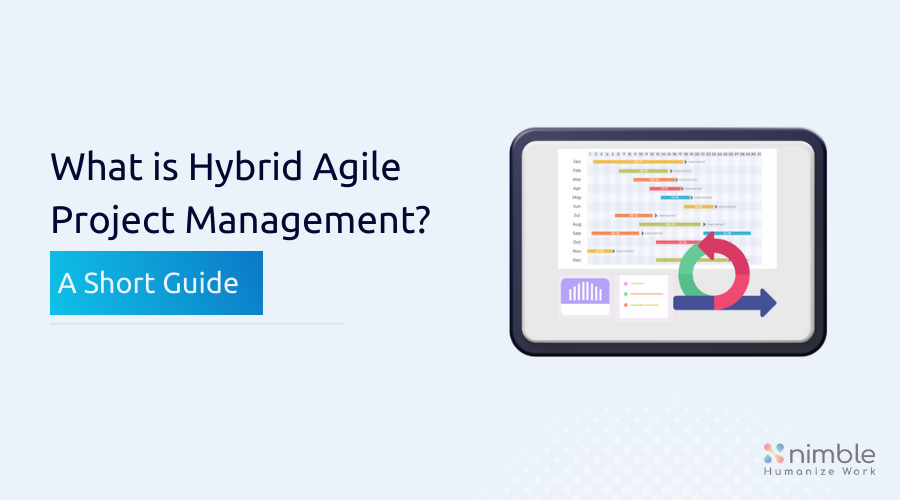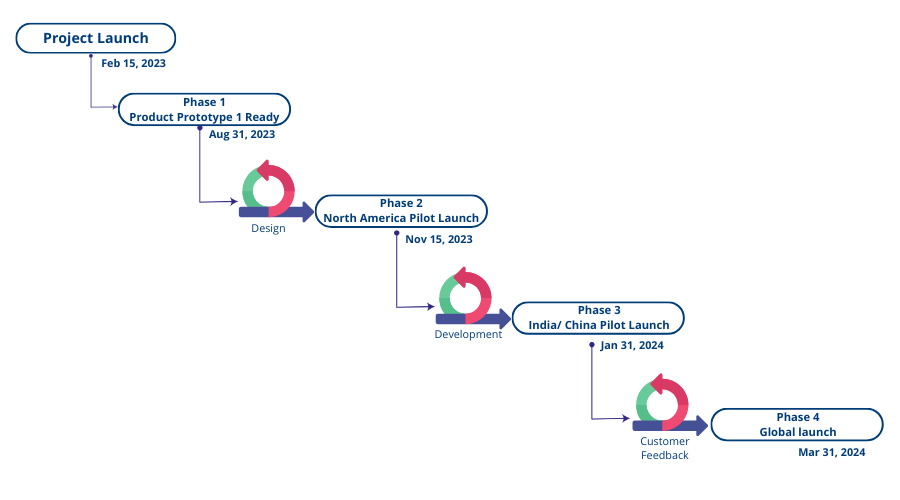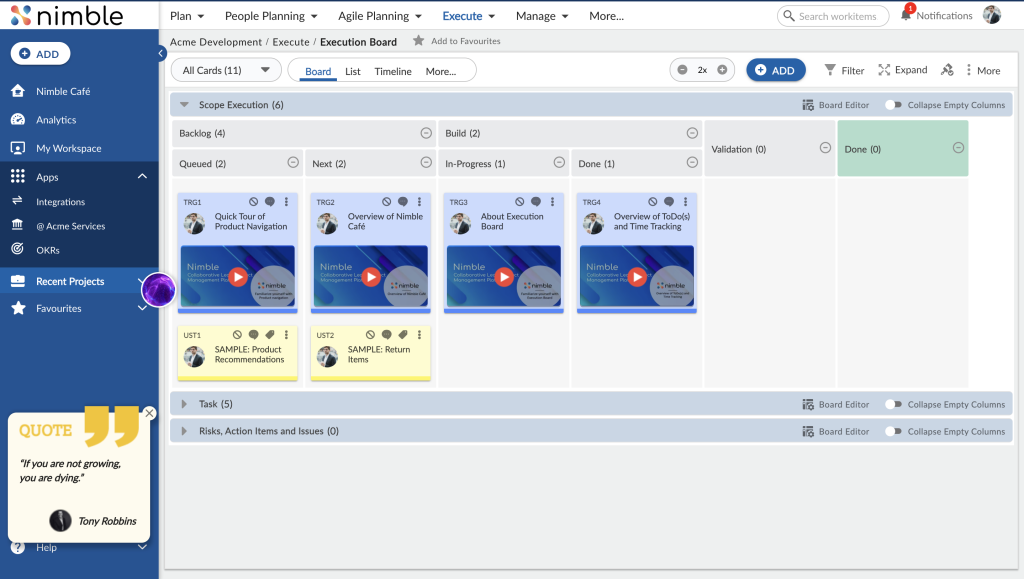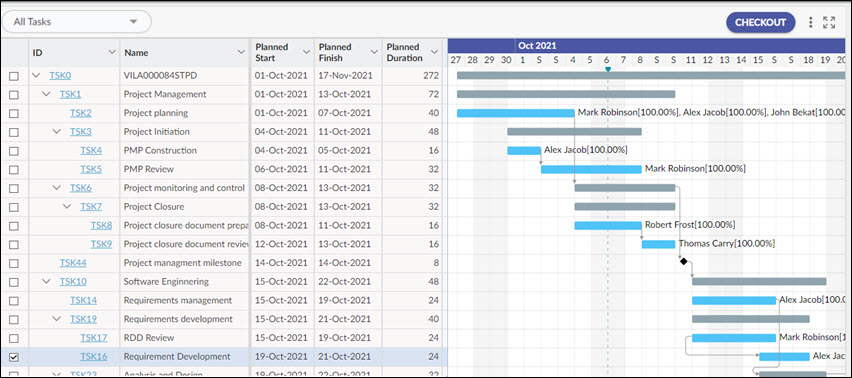Navigate to
What is Hybrid Agile Project Management? A Short Guide
- 6 mins read
-
By Elizabeth Harrin
- Updated on February 16, 2024

When we speak to project managers, we’ll often hear things like: “Oh, I don’t do agile,” or “I don’t use Gantt charts because we’re agile.”
It’s almost as if there were only two ways of getting work done.
We’re here to tell you that there is a versatile, flexible approach that is a blend of good practices. So whether you fall into the waterfall camp or live and breathe agile at work, read on, because hybrid agile might just change the way you approach your projects.
Defining Hybrid Agile
Hybrid is a word you might have seen used in your own organization, but what does hybrid mean in project management?
Hybrid means ‘made by combining two different elements’ and hybrid agile is a way of working where iterative and predictive methods, tools and techniques are blended to create a flexible way of managing projects.
The blending could happen within a single project, and we’ll share some examples of that later, or across the portfolio. A portfolio can be made up of a mix of projects, some fully predictive or traditional, others fully agile. We’ve found this definition in use by project leaders who use it to talk about the project mix instead of an individual project.
The thing both the single project and portfolio definitions have in common is that hybrid project management is a blend of practices traditionally identified with predictive (waterfall) or iterative (agile) ways of working.
In other words, project leaders are taking the best of what works from the whole spectrum of project management approaches and tailoring the way you do your work to make it perfectly fit the project. Following a process doesn’t have to be either one way or the other: it’s OK, and often preferable, to blend, pick and choose. Some projects need waterfall approaches, some need agile, and some need both.
Is Hybrid Agile New?
Hybrid ways of working aren’t exactly new. Ask any experienced project manager and you’ll find they rarely follow ‘the book’ because it’s always smart to flex how you approach work to suit the context, team, people, and because it can be hard to implement (and stick to) just one way of doing things.
Both agile and traditional, linear approaches have been around for a long time and project managers have taken tools and techniques from various project delivery approaches to create in-house methodologies that work for them, using the techniques flexibly to empower project success. Many organizations will have multiple methodologies so they can run agile and linear projects in-house as required.
Tailoring your approach is positively encouraged by the professional standards as well. The PMBOK 7th edition talks about how to tailor project methods, and PRINCE2 7 and the APM Body of Knowledge do the same.
If you are hearing more people talk about hybrid ways of working, it’s because organizations are recognizing the value in letting people choose the best way to deliver their work.
Differences Between Agile and Waterfall
Tailoring is great as a philosophy, but how do you know what is going to be right for your project?
Linear (waterfall) methods are good for low risk projects with clarity over the requirements and deliverables. Typically, making changes to the agreed scope costs more the closer you are to the end of the project.
Agile approaches are perfectly suited to higher risk projects with a set of requirements that might change over time as the product evolves. However, this might come at a higher cost overall.
Hybrid means combining the best of all approaches. It means rejecting the dichotomy that there are only two ways to get projects done and considering project delivery as a spectrum. Your project falls somewhere along the line and you can flex your tools to fit the way that best works for your team. And you don’t need multiple tools for multiple ways of working. Nimble Hybrid has features that are available to all team members, whether you want to view burndown charts or milestones for the next quarter.
Examples of Hybrid Agile at Work
Typically, teams developing software use agile approaches and hardware teams use waterfall/linear approaches, an idea proposed at the Agile Alliance conference in 2013 by Erick Bergmann and Andy Hamilton. But today we don’t have to be limited to tech projects.
Here are some examples of where projects can be set up to accommodate both predictive and iterative ways of working, creating a hybrid project management approach overall.
👉 Linear at organizational level to set quarterly OKRs while using agile to flexibly complete the work
👉 Linear for program management but individual projects use agile
👉 Linear for project management, business change management and organizational governance while workstreams like tech or marketing use agile.
Often, we see teams using waterfall for top level planning and agile for delivery. It’s adaptable and easy to make it work.
Other times, there is a clear split in the organization between the projects that are run using agile ways of working and the projects that follow a predictive path. The challenge here is making sure there is consolidated department, program or portfolio reporting, so having one project management tool that enables reporting for both types of project means you can see progress against all in-flight work.
What makes a Project Suitable for a Hybrid Agile Project Management Approach?
Does your project have components that are flexible or uncertain in places, but other components that have fixed dates?
Does your project require a lot of collaboration between the teams and would work really well if team members allocated to the project on a full time basis?
Does your leadership team want to go fast with design and delivery but have constraints around budget and dates?
All of these situations would lend themselves to a hybrid agile approach.
Hybrid project management works best in an environment where the team overall is comfortable using different ways of working. For example, you might have developers who are used to working in agile squads and a program manager comfortable with creating a Gantt chart and following the organizational governance processes in a linear fashion. There need to be enough experts in the process to cover all ways of working.
Hybrid project management will not be as effective if you are still transitioning to agile development methods or have never used predictive methods because the team won’t be comfortable enough at knowing what works. Make sure you’ve got enough expertise from different approaches, methodologies and frameworks before you try to draw in aspects of each. Software makes it easier as you can define workflows to help team members move through each project process or phase in a standardized way.
Hybrid in Practice
If you are running iterative and predictive projects, choose project management software that lets you manage them both within the same tool for ultimate flexibility.
If you’re looking at running a single project in a hybrid way, the right software is even more important.
Tools like Nimble Hybrid make it easy to empower the team to work in the most effective way.
Some members can work with critical path planning and Gantt charts while others on the same project use burndown charts to track progress. A single tool provides full transparency and visibility so the whole team can track in one place.
Whether you are decomposing scope or building user stories, when everything is in one tool the whole team can monitor progress and discuss requirements in the same place with full traceability.
Combine metrics with dashboards so there is one version of the truth, reporting effort, scorecards, variances and more.
Ready to go Hybrid?
We love Hybrid Agile Project Management because it’s so flexible, practical, and empowering for team members. When people feel supported and they have the right tools to do the job, they can get more done with fewer distractions.
There is no single best way to implement hybrid agile ways of working but instead it’s up to the team to adopt best in class methods and techniques to ensure that you get the results you want while balancing team preference, organizational culture and the art of the possible. The right software tools make the transition easy!
Nimble Hybrid Agile empowers teams to seamlessly implement Hybrid Agile projects by combining the flexibility of Agile methodologies with the structured approach of traditional project management, ensuring adaptability and efficiency throughout the project lifecycle. Signup for a Free trial.
About Author:
Agile 101
What is an Agile Epic? Benefits of Using Them
Learn what an Agile epic is, how it can streamline project management, and the benefits of incorporating epics into your Agile workflow.
Is Hybrid Agile Right for your Team? Here’s what you need to know
Explore the suitability of Hybrid Agile for your project needs in our comprehensive article. We delve into the benefits, considerations, and key factors to help you determine if this approach aligns with your organization’s goals and project requirements.
What is Hybrid Agile Project Management? A Short Guide
Discover the power of Hybrid Agile project management: achieve flexibility and structure for successful project execution. Learn how to harness this dynamic approach.
Dynamic System Development Method (DSDM)
Dynamic Systems Development Method, DSDM for short, seeks to do what came to be known as ‘Agile’ well before the manifesto was written. Learn more about its philosophy, principles, pillars, and practices.
What is Scrum Methodology? An Introduction for Agile Teams
Scrum is an agile project management framework that prioritizes collaboration and iterative development for efficient results.
Scrum of Scrums: A Starting Point to Scaling Agile
Scrum of scrums is an approach to coordinate multiple scrum teams working together. Learn how it works, how to get started and how it differs from competing approaches.
Pair programming is a programming method in which two people work together on a single program. The first person is the “Driver”, who writes the code, the other person is the “Navigator” who reviews each line of code as it is typed, checking for errors. They exchange their roles on a regular basis.
Code refactoring in Agile is a well-known technique to keep a codebase healthy and amenable to change. Learn what it is and a sound process to follow.
Speed up your Agile planning and execution!
Signup for a FREE Trial of Nimble Agile






